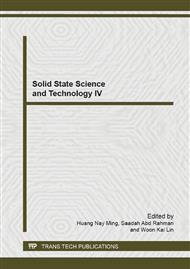p.439
p.447
p.452
p.460
p.477
p.481
p.490
p.500
p.505
Interface-Induced Modifications of Polarization in Nanoscale Ferroelectric Superlattices
Abstract:
A thermodynamic model to study the effect of interface intermixing on polarization of ferroelectric superlattices composed of a ferroelectric and paraelectric layers is developed. Interface intermixing forms an intermixed layer with property different from its individual layers, leading to inhomogeneous ferroelectric properties in the superlattices. Polarization induces near the interface of paraelectric layers, which extends into the layer over a distance governed by its characteristic length. Dependence of polarization on periodic thickness indicates an interface-induced modification of ferroelectricity in superlattices. Enhancement in polarization of superlattices is shown to be possible, if certain interface property and periodic thickness met.
Info:
Periodical:
Pages:
477-480
Citation:
Online since:
February 2014
Authors:
Keywords:
Price:
Сopyright:
© 2014 Trans Tech Publications Ltd. All Rights Reserved
Share:
Citation:


